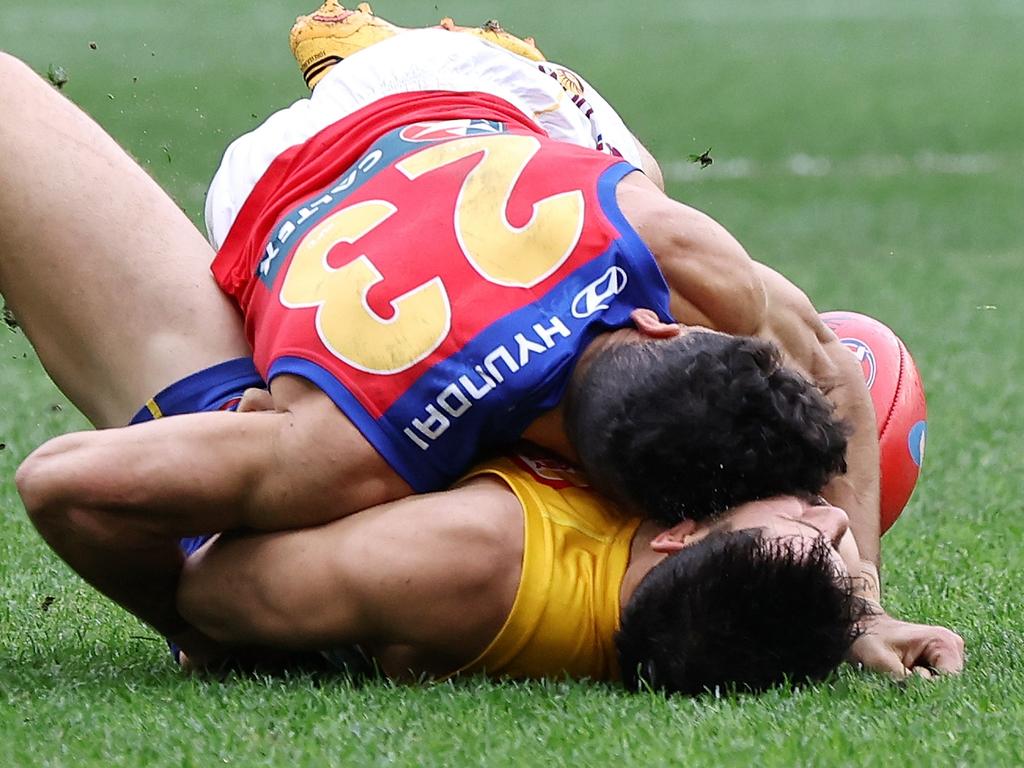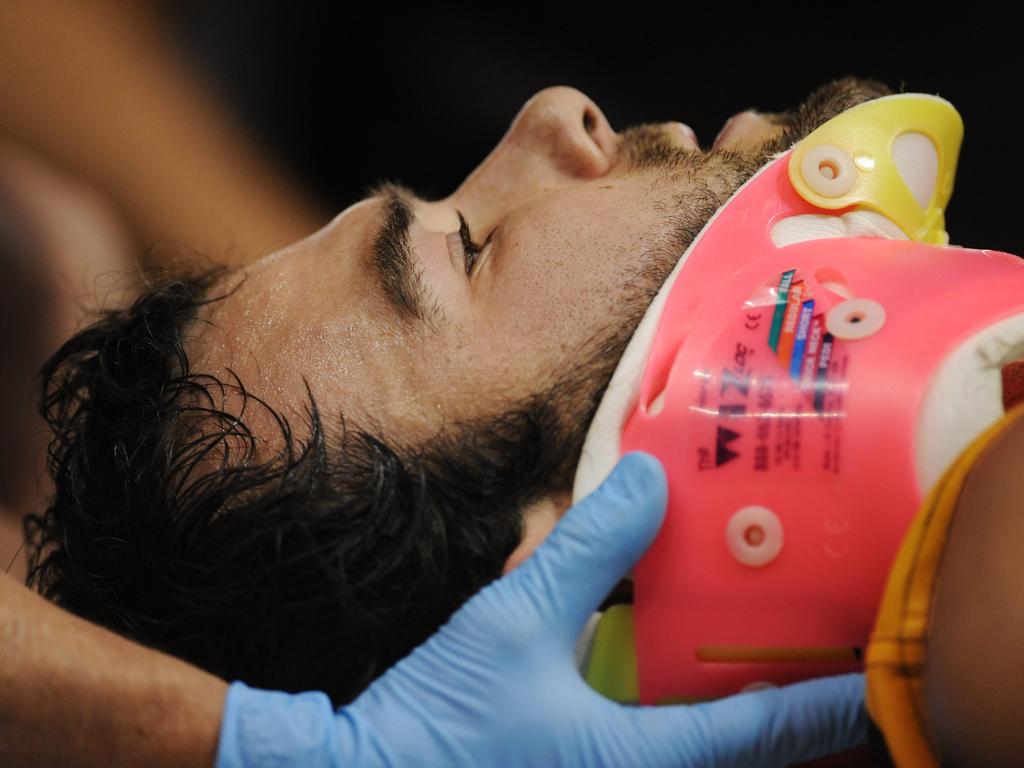Mark Robinson: What’s more important, the fabric of the game, or of life itself?
Andrew Dillon’s Brave New World is here, and it’s not just about the heavy cloud of future litigation, it’s also about the pain of concussed former players and their families, writes Mark Robinson.

This is Andrew Dillon’s Brave New World.
The original, published by English novelist Aldous Huxley in 1932, was about a series of social engineering to make an imagined dystopian society, which created fear and confusion.
Sound familiar?
Dillon’s world – the footy world – is not imagined. In 2024, he is re-engineering football to try to ensure the health and safety of the players.
Let’s not kid ourselves. There’s the health and safety aspect and there’s also the umbrella of litigation. It hangs heavy over the game. It’s not just about the money, either.
Former players and their partners are in pain. Some are dying.
So, what’s more important? The fabric of the game, as Jonathan Brown argued for this week, or the fabric of life itself?
On the one hand we weep for Danny Frawley and are disturbed by Nigel Kellett, and on the other hand, we denounce the AFL for trying to curb head trauma, which is linked to all kinds of mental demons. Suicide included.

The brave new world has to be a caring new world.
The tackles by Toby Bedford and Charlie Cameron set the footy world on fire. Of course it was jarring. Just read all the comments from coaches and current and former players.
My flinch reaction echoed mostly everyone elses. Bedford shouldn’t be in trouble. “We’ve got to accept that accidents happen in football and not every bad outcome has to have a villain,’’ I wrote in Monday’s Herald Sun.
It’s now dawned that it’s not about the tackler, it’s about the player who’s had his head smashed into the ground, causing concussion.
Clearly, the matrix is out of whack. Three weeks for a bad tackle, one week for an elbow to the head, a fine for a gut-punch and, of course, Patrick Dangerfield arguing his way out of a week’s suspension, have confused everyone.
What’s reasonable and unreasonable in different situations?
The decision to throw out the cases of both Cameron and Bedford on Thursday night swapped confusion with comedy. The AFL, for all of its best intention, is being laughed at.

Despite its rules and regulations and how it was applied being shredded this time around, it’s clear – or will be when the R&Rs are rewritten – that head trauma in tackles is a no-go zone.
Indeed, for 150 or so years, the head was an afterthought.
Think back. In 1996, Collingwood’s Alan Richardson was poleaxed by Brisbane’s Michael Voss on the wing at the Gabba. YouTube it. Voss ignored the ball and stopped a full-pelt Richardson in his tracks. Richardson had a fit on the ground, woke up in the ambulance, and had a birthday cake delivered to him in the hospital that night by teammates Gavin Brown and Damien Monkhorst. Richardson played the next week. And so did Voss.
If it happened today, Richardson would rest for three weeks and Vossy for probably six weeks, courtesy of the tribunal.
More recently, in 2010, Hawthorn’s Jordan Lewis was knocked-out in a savage collision with Jarrod Harbrow at Marvel Stadium. Lewis has said the impact was so severe, his ears folded forward. Unbelievably, he returned to the field after halftime.
Thankfully, footy has evolved. It’s taken its time, though. Firstly, the front-on bump was outlawed, then the bump to the head was suspendable, and the sling tackle – which amazingly was an accepted practice specifically designed to hurt the ball winner – soon followed.

Now, the dangerous tackle is front of mind. It has been for two seasons.
Last year, there were 30 suspensions for dangerous tackles and this year there’s been 11 charges and nine suspensions. The players are learning. And they will be forced to keep learning.
Leigh Matthews played for 25 years, coached for 20 years and has commentated for another 20 years. He has seen more changes to the game than mostly anyone.
He says the most change has come since the players and coaches became full-time professionals, which is this century. That and what he says is the “concussion conundrum’’.
“A lot of the things that have changed has been forced on the game by what I term is the concussion conundrum,” he said.
“The whole concussion issue, which has opened up this century; the connection between concussion and things that happen over your life, is there.
“The concussion conundrum provide the game and people running the game a whole lot of tentacles, which they are trying to manage, to prevent litigation, to prevent players being hurt.
“Is the game any worse that you can’t shirt-front anyone anymore? I think not. It has not suffered one iota.
“The tackling … you still can still bump, but you can’t bump high. That’s clear, there’s no confusion. It seems to be under this concussion conundrum the people running the game have said if you tackle, pin somebody’s arms, take him to the ground, and his head hits the ground, then you’re liable.
“I understand it. But I don’t think players and fans do, and half the coaches and clubs don’t.’’
Matthews described today’s tackling as an “aggressive, powerful act’’ that required the tackler to apply “great vigour and aggression and an almost violent act to pin the arms’’ to an equally powerful player with the ball.
“And sometimes they go to ground and occasionally the head hits the ground … so then you’re liable,’’ he said. “The game is trying to minimise head contact in all forms and if you’re talking about changing the fabric of the game, I think that’s a great over-reaction.
“The game is evolving.’’
Matthews added: “I think the whole spectacle of the game has never been better.’’
Forever, players were told and taught to tackle the waist and hips, and dump. Then what happened, virtually when they became professional, players were taught to lift the ball to get a handball away. The response to that was players were told to pin the arms so the ball couldn’t be handballed. So, they pinned and dumped (the player) and there was the problem.”
The AFL now says players must not pin and dump, and not put players in a vulnerable position which, they say, was exactly what Bedford and Cameron did.
“It’s up to the players applying the tackle to be aware of that,’’ Matthews said.
“If you want to take the risk, by all means, but you make sure his head doesn’t hit the ground. If it does, you’re probably going to get a suspension. I personally don’t have a problem with that. I only sit I the stands and watch it, but sometimes I think people playing the game and coaching the game should know the lay of the land now, shouldn’t they?’’

In fact, Matthews said he liked the dangerous tackle crackdown because he was “happy to make it harder for the tackler’’.
“They’ve made it so much harder for the bloke with the ball,’’ he said.
“The one debatable (thing) is the penalty. I thought Heeney throwing his arm back, bloodied the bloke’s nose, that’s worth a week,’’ he said. “(But) what Charlie Cameron and (Toby) Bedford did is – at-worst – a week. They executed a bad tackle and the fact it got a severe impact, so it goes up to three weeks, that’s not justice to me.’’
Peter Jess has been the loudest voice in the “concussion conundrum’’.
For more than a decade, he has challenged the AFL’s return-to-play protocol and argued for greater safety for the game’s combatants. Once considered the king crackpot of the concussion crusaders, Jess was, arguably, ahead of the curve.
He says the AFL’s latest measures are necessary to save the players and potentially the game.

“The AFL has embarked on a campaign now where they realise they have to address the issues of protecting players and not only do they have to talk about it, they have to do it,’’ Jess said. “One of the rationales in doing that is rule changes. I suspect is what they haven’t done is given sufficient weight as to how it should be activated inside the playing cohort because at the moment it’s top-down not bottom-up.
“By that I mean the players need to understand exactly what’s happening in the game. At the moment, nobody knows what’s going on, not only in terms of the rules, but also the interpretations from umpires, and that’s a problem.
“How is it that a tackle can be laid, no free-kick paid and then a three-week suspension imposed, and then have it thrown out at appeal?
“Education at lower levels and guidance from the AFL is urgently needed.’’
He stressed that the clamp on dangerous tackles was “good” for the game.
“If you have a tackle where somebody can’t break his fall because his arms are pinned and their head hits the ground, that is an issue,’’ Jess said.
“I’m all for changes about safety. If we make this game safer, it means everyone can enjoy a sport without worrying whether they are going to have a brain trauma. At the moment, they can’t do that.’’

He said Dillon’s brave new world was about “re-engineering” the game.
“Without a re-engineering, we will see a rise in the drop-off in participation at (both) junior and senior level,” Jess said. “There’s no question this is uncharted territory in terms of what we knew and what we’re about to see. This is the brave new world for collision-based sport with the focus on prevention, mitigation and safety.’’
Jess argued the game “cannot exist in its present form’’ if change was not adopted and supported at all levels.
“In the US, tag football is the fastest growing sport and, in fact, they’re calling for it to be an Olympic sport,” Jess said. “The fabric of our game has to be about safety and not about brutality. Indigenous football can exist without a tackle, as we’ve seen in Gaelic football. Perhaps a hybrid model of that is our future. The focus is on impeding and not tackling, it’s on speed and skill and not combat and constant stoppage.”




